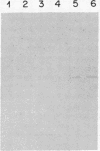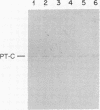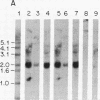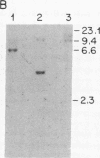Abstract
We have isolated a cDNA clone corresponding to the Mr 38,000 catalytic subunit of bovine type 2A protein phosphatase. The cDNA was isolated from a bovine adrenal gland cDNA library through the use of oligonucleotide probes whose sequences were based on partial amino acid sequence obtained from cyanogen bromide fragments of the purified cardiac enzyme. The entire 1724-base-pair cDNA has been sequenced and found to contain an open reading frame coding for a protein of 325 amino acids having a calculated molecular weight of 37,320. The deduced amino acid sequence contains the experimentally determined sequences of five different cyanogen bromide peptides. Transfection of COS-m6 cells with the cloned cDNA resulted in transient expression of a protein that could be detected by immunoblot analysis with a monoclonal antibody directed against the purified cardiac protein phosphatase. The expressed protein had the same apparent molecular weight as the purified enzyme when analyzed by NaDodSO4/polyacrylamide gel electrophoresis, suggesting that this clone contains the entire coding region of the phosphatase mRNA. The cloned cDNA hybridizes to a mRNA of 2.0 kilobases in bovine heart and adrenal gland. Under conditions of reduced stringency, the cDNA also hybridizes to a mRNA species of 1.2 kilobases in cardiac tissue.
Full text
PDF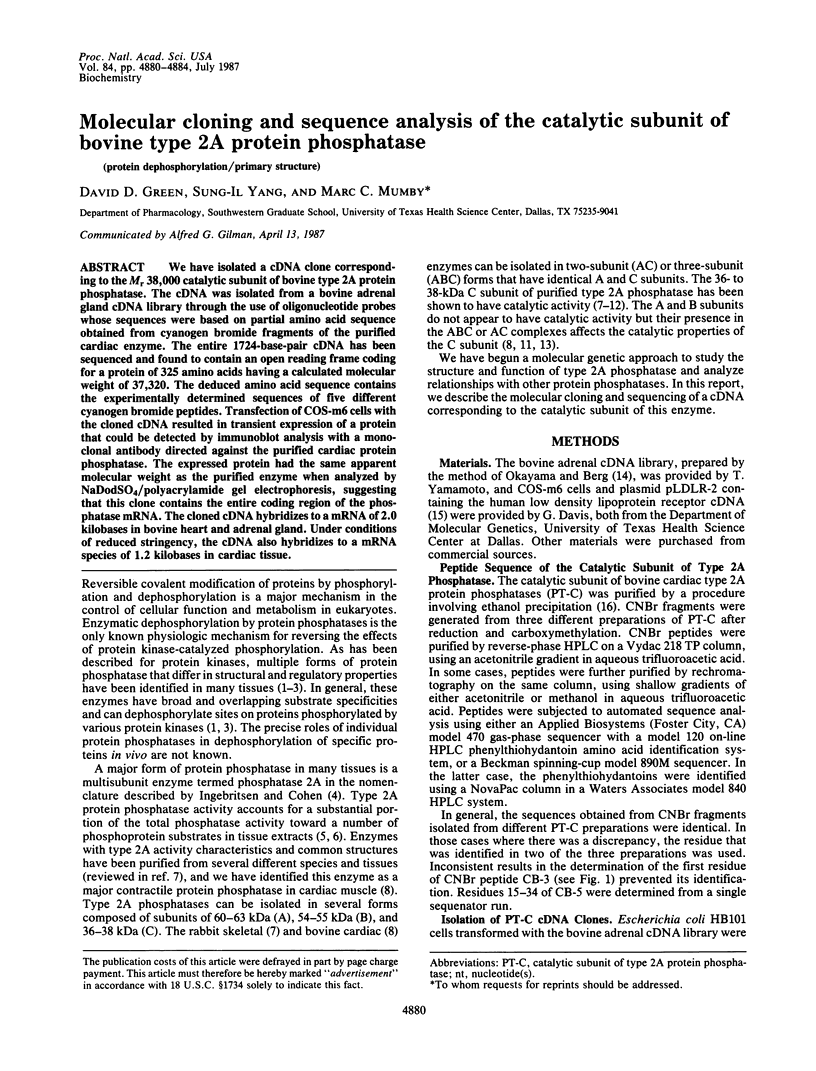
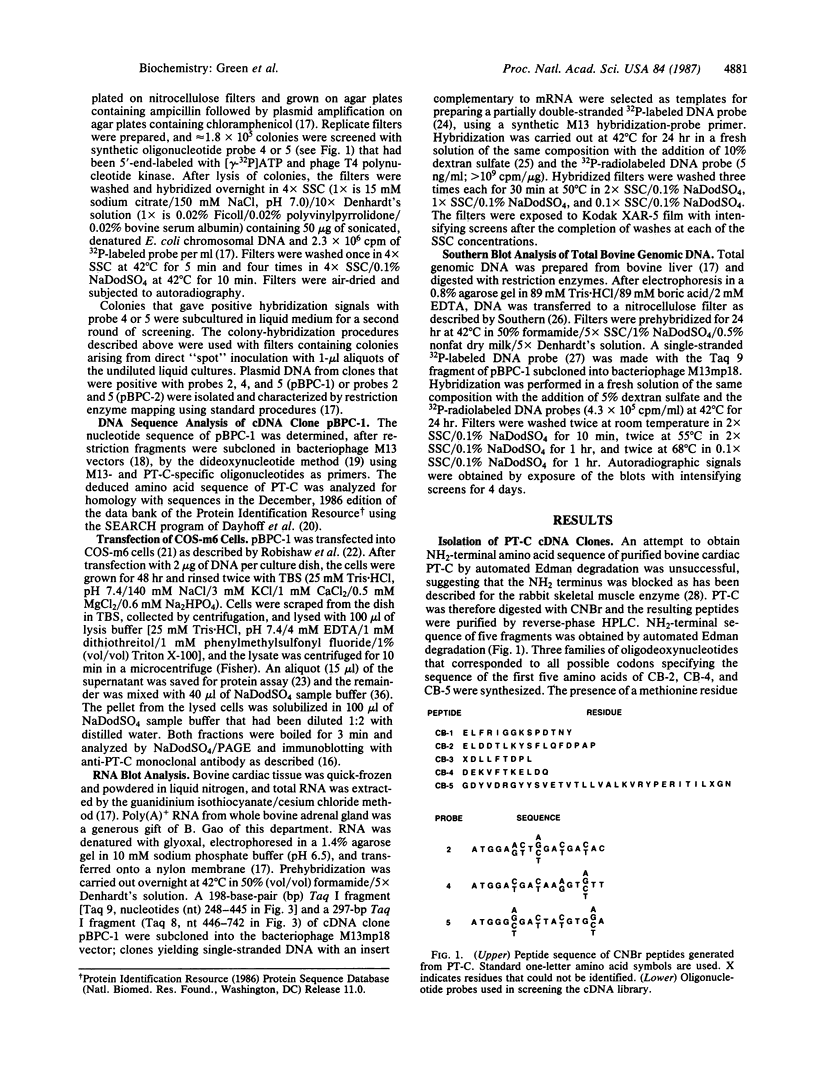
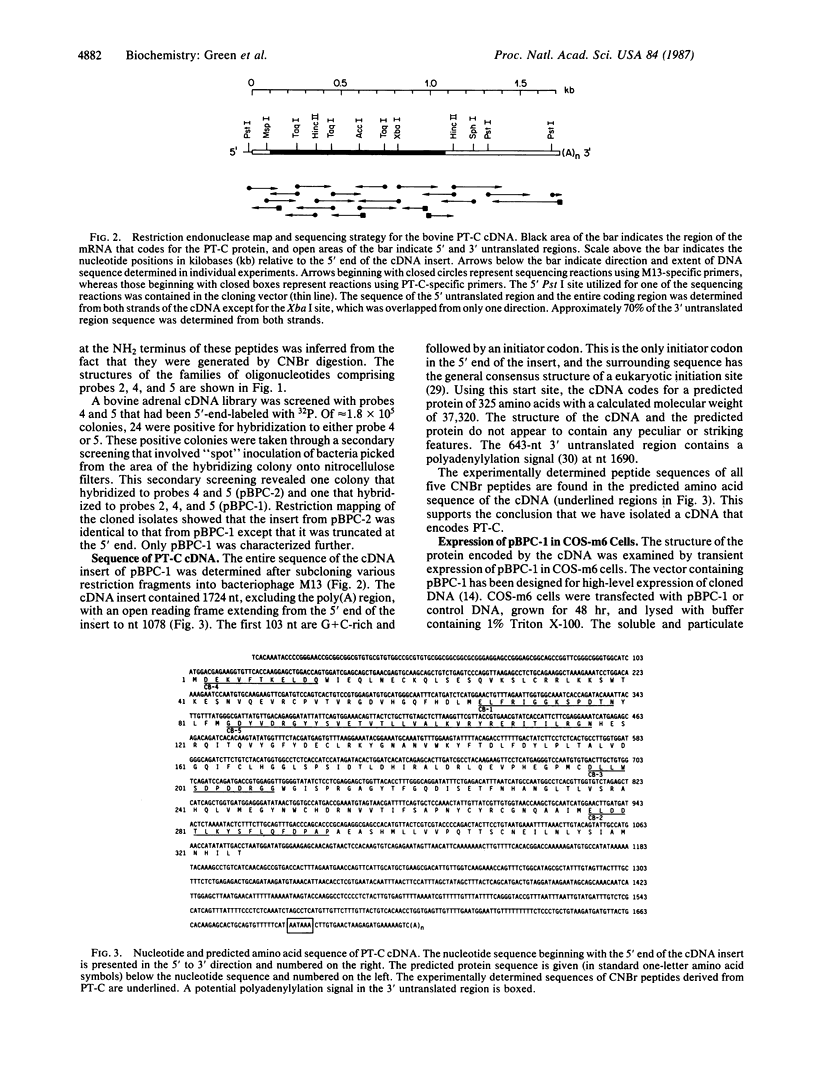

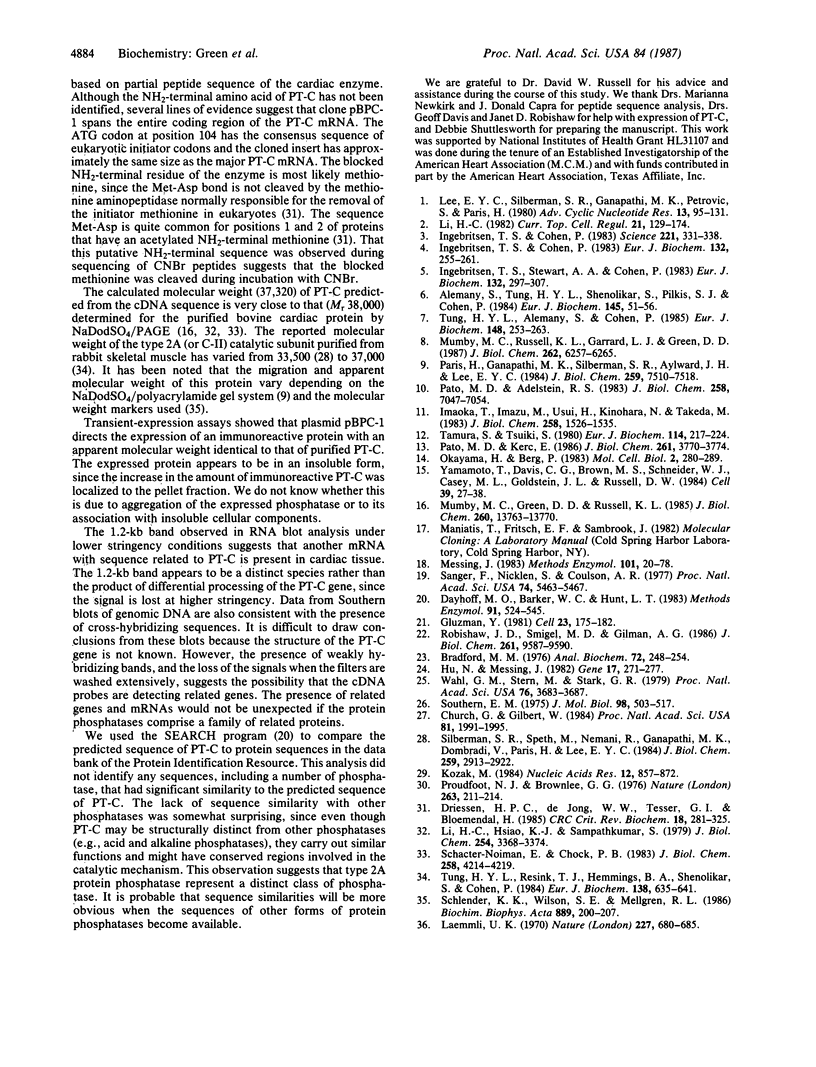
Images in this article
Selected References
These references are in PubMed. This may not be the complete list of references from this article.
- Alemany S., Tung H. Y., Shenolikar S., Pilkis S. J., Cohen P. The protein phosphatases involved in cellular regulation. Antibody to protein phosphatase-2A as a probe of phosphatase structure and function. Eur J Biochem. 1984 Nov 15;145(1):51–56. doi: 10.1111/j.1432-1033.1984.tb08520.x. [DOI] [PubMed] [Google Scholar]
- Bradford M. M. A rapid and sensitive method for the quantitation of microgram quantities of protein utilizing the principle of protein-dye binding. Anal Biochem. 1976 May 7;72:248–254. doi: 10.1006/abio.1976.9999. [DOI] [PubMed] [Google Scholar]
- Church G. M., Gilbert W. Genomic sequencing. Proc Natl Acad Sci U S A. 1984 Apr;81(7):1991–1995. doi: 10.1073/pnas.81.7.1991. [DOI] [PMC free article] [PubMed] [Google Scholar]
- Dayhoff M. O., Barker W. C., Hunt L. T. Establishing homologies in protein sequences. Methods Enzymol. 1983;91:524–545. doi: 10.1016/s0076-6879(83)91049-2. [DOI] [PubMed] [Google Scholar]
- Driessen H. P., de Jong W. W., Tesser G. I., Bloemendal H. The mechanism of N-terminal acetylation of proteins. CRC Crit Rev Biochem. 1985;18(4):281–325. doi: 10.3109/10409238509086784. [DOI] [PubMed] [Google Scholar]
- Gluzman Y. SV40-transformed simian cells support the replication of early SV40 mutants. Cell. 1981 Jan;23(1):175–182. doi: 10.1016/0092-8674(81)90282-8. [DOI] [PubMed] [Google Scholar]
- Hu N., Messing J. The making of strand-specific M13 probes. Gene. 1982 Mar;17(3):271–277. doi: 10.1016/0378-1119(82)90143-3. [DOI] [PubMed] [Google Scholar]
- Imaoka T., Imazu M., Usui H., Kinohara N., Takeda M. Resolution and reassociation of three distinct components from pig heart phosphoprotein phosphatase. J Biol Chem. 1983 Feb 10;258(3):1526–1535. [PubMed] [Google Scholar]
- Ingebritsen T. S., Cohen P. Protein phosphatases: properties and role in cellular regulation. Science. 1983 Jul 22;221(4608):331–338. doi: 10.1126/science.6306765. [DOI] [PubMed] [Google Scholar]
- Ingebritsen T. S., Cohen P. The protein phosphatases involved in cellular regulation. 1. Classification and substrate specificities. Eur J Biochem. 1983 May 2;132(2):255–261. doi: 10.1111/j.1432-1033.1983.tb07357.x. [DOI] [PubMed] [Google Scholar]
- Ingebritsen T. S., Stewart A. A., Cohen P. The protein phosphatases involved in cellular regulation. 6. Measurement of type-1 and type-2 protein phosphatases in extracts of mammalian tissues; an assessment of their physiological roles. Eur J Biochem. 1983 May 2;132(2):297–307. doi: 10.1111/j.1432-1033.1983.tb07362.x. [DOI] [PubMed] [Google Scholar]
- Kozak M. Compilation and analysis of sequences upstream from the translational start site in eukaryotic mRNAs. Nucleic Acids Res. 1984 Jan 25;12(2):857–872. doi: 10.1093/nar/12.2.857. [DOI] [PMC free article] [PubMed] [Google Scholar]
- Laemmli U. K. Cleavage of structural proteins during the assembly of the head of bacteriophage T4. Nature. 1970 Aug 15;227(5259):680–685. doi: 10.1038/227680a0. [DOI] [PubMed] [Google Scholar]
- Lee E. Y., Silberman S. R., Ganapathi M. K., Petrović S., Paris H. The phosphoprotein phosphatases: properties of the enzymes involved in the regulation of glycogen metabolism. Adv Cyclic Nucleotide Res. 1980;13:95–131. [PubMed] [Google Scholar]
- Li H. C., Hsiao K. J., Sampathkumar S. Characterization of a novel alkaline phosphatase activity which co-purifies with a phosphorylase (phosphoprotein) phosphatase of Mr = 35,000 cardiac muscle. J Biol Chem. 1979 May 10;254(9):3368–3374. [PubMed] [Google Scholar]
- Li H. C. Phosphoprotein phosphatases. Curr Top Cell Regul. 1982;21:129–174. [PubMed] [Google Scholar]
- Messing J. New M13 vectors for cloning. Methods Enzymol. 1983;101:20–78. doi: 10.1016/0076-6879(83)01005-8. [DOI] [PubMed] [Google Scholar]
- Mumby M. C., Green D. D., Russell K. L. Structural characterization of cardiac protein phosphatase with a monoclonal antibody. Evidence that the Mr = 38,000 phosphatase is the catalytic subunit of the native enzyme(s). J Biol Chem. 1985 Nov 5;260(25):13763–13770. [PubMed] [Google Scholar]
- Mumby M. C., Russell K. L., Garrard L. J., Green D. D. Cardiac contractile protein phosphatases. Purification of two enzyme forms and their characterization with subunit-specific antibodies. J Biol Chem. 1987 May 5;262(13):6257–6265. [PubMed] [Google Scholar]
- Okayama H., Berg P. A cDNA cloning vector that permits expression of cDNA inserts in mammalian cells. Mol Cell Biol. 1983 Feb;3(2):280–289. doi: 10.1128/mcb.3.2.280. [DOI] [PMC free article] [PubMed] [Google Scholar]
- Paris H., Ganapathi M. K., Silberman S. R., Aylward J. H., Lee E. Y. Isolation and characterization of a high molecular weight protein phosphatase from rabbit skeletal muscle. J Biol Chem. 1984 Jun 25;259(12):7510–7518. [PubMed] [Google Scholar]
- Pato M. D., Adelstein R. S. Purification and characterization of a multisubunit phosphatase from turkey gizzard smooth muscle. The effect of calmodulin binding to myosin light chain kinase on dephosphorylation. J Biol Chem. 1983 Jun 10;258(11):7047–7054. [PubMed] [Google Scholar]
- Pato M. D., Kerc E. Limited proteolytic digestion and dissociation of smooth muscle phosphatase-I modifies its substrate specificity. Preparation and properties of different forms of smooth muscle phosphatase-I. J Biol Chem. 1986 Mar 15;261(8):3770–3774. [PubMed] [Google Scholar]
- Proudfoot N. J., Brownlee G. G. 3' non-coding region sequences in eukaryotic messenger RNA. Nature. 1976 Sep 16;263(5574):211–214. doi: 10.1038/263211a0. [DOI] [PubMed] [Google Scholar]
- Robishaw J. D., Smigel M. D., Gilman A. G. Molecular basis for two forms of the G protein that stimulates adenylate cyclase. J Biol Chem. 1986 Jul 25;261(21):9587–9590. [PubMed] [Google Scholar]
- Sanger F., Nicklen S., Coulson A. R. DNA sequencing with chain-terminating inhibitors. Proc Natl Acad Sci U S A. 1977 Dec;74(12):5463–5467. doi: 10.1073/pnas.74.12.5463. [DOI] [PMC free article] [PubMed] [Google Scholar]
- Schlender K. K., Wilson S. E., Mellgren R. L. Catalytic subunit of the polycation-stimulated protein phosphatase. Effect of proteolysis on polycation stimulation. Biochim Biophys Acta. 1986 Nov 28;889(2):200–207. doi: 10.1016/0167-4889(86)90105-9. [DOI] [PubMed] [Google Scholar]
- Shacter-Noiman E., Chock P. B. Properties of a Mr = 38,000 phosphoprotein phosphatase. Modulation by divalent cations, ATP, and fluoride. J Biol Chem. 1983 Apr 10;258(7):4214–4219. [PubMed] [Google Scholar]
- Silberman S. R., Speth M., Nemani R., Ganapathi M. K., Dombradi V., Paris H., Lee E. Y. Isolation and characterization of rabbit skeletal muscle protein phosphatases C-I and C-II. J Biol Chem. 1984 Mar 10;259(5):2913–2922. [PubMed] [Google Scholar]
- Southern E. M. Detection of specific sequences among DNA fragments separated by gel electrophoresis. J Mol Biol. 1975 Nov 5;98(3):503–517. doi: 10.1016/s0022-2836(75)80083-0. [DOI] [PubMed] [Google Scholar]
- Tamura S., Tsuiki S. Purification and subunit structure of rat-liver phosphoprotein phosphatase, whose molecular weight is 260000 by gel filtration (phosphatase IB). Eur J Biochem. 1980 Oct;111(1):217–224. doi: 10.1111/j.1432-1033.1980.tb06096.x. [DOI] [PubMed] [Google Scholar]
- Tung H. Y., Alemany S., Cohen P. The protein phosphatases involved in cellular regulation. 2. Purification, subunit structure and properties of protein phosphatases-2A0, 2A1, and 2A2 from rabbit skeletal muscle. Eur J Biochem. 1985 Apr 15;148(2):253–263. doi: 10.1111/j.1432-1033.1985.tb08833.x. [DOI] [PubMed] [Google Scholar]
- Tung H. Y., Resink T. J., Hemmings B. A., Shenolikar S., Cohen P. The catalytic subunits of protein phosphatase-1 and protein phosphatase 2A are distinct gene products. Eur J Biochem. 1984 Feb 1;138(3):635–641. doi: 10.1111/j.1432-1033.1984.tb07962.x. [DOI] [PubMed] [Google Scholar]
- Wahl G. M., Stern M., Stark G. R. Efficient transfer of large DNA fragments from agarose gels to diazobenzyloxymethyl-paper and rapid hybridization by using dextran sulfate. Proc Natl Acad Sci U S A. 1979 Aug;76(8):3683–3687. doi: 10.1073/pnas.76.8.3683. [DOI] [PMC free article] [PubMed] [Google Scholar]
- Yamamoto T., Davis C. G., Brown M. S., Schneider W. J., Casey M. L., Goldstein J. L., Russell D. W. The human LDL receptor: a cysteine-rich protein with multiple Alu sequences in its mRNA. Cell. 1984 Nov;39(1):27–38. doi: 10.1016/0092-8674(84)90188-0. [DOI] [PubMed] [Google Scholar]



